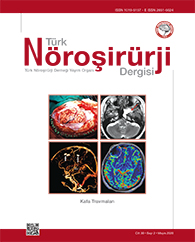Türk Nöroşirürji Dergisi
2020 , Vol 30 , Num 2
Conventional and Advanced Imaging Findings in Traumatic Brain Injury
1Selcuk Üniversitesi Tıp Fakültesi Radyoloji Anabilim Dalı, Konya, Türkiye
Traumatic brain injury is one of the most important causes of mortality and morbidity in the world. Although most of the relevant
patients admitted to the hospital are diagnosed with mild brain injury, the condition can cause permanent damage in the long
term. It can be classified according to the occurrence time, localization, mechanism of occurrence, or clinical severity of the injury.
Primary injury occurs during the trauma and develops within hours. Secondary injury can be defined as the complications of primary
traumatic injury and takes hours and days. Unlike primary damage, secondary damage can be prevented. The purpose of imaging
is to demonstrate the primary damage and to identify the causes of preventable secondary damage. The first option in imaging
should be non-enhanced computed tomography. MRI evaluation is recommended in the presence of new neurological deficits in
the acute period or subacute-chronic period together with clinical findings that cannot be explained by CT. In fact, the sensitivity of
MRI is higher than CT in showing epidural-subdural bleeding, subarachnoid hemorrhage, contusion, brainstem injury, and diffuse
axonal injury. In conventional CT and MRI imaging, an incompatibility can be present between the findings and the clinical outcome.
In this case, the lesions can be demonstrated with higher sensitivity with advanced imaging methods. Advanced imaging can be
performed with dual energy for CT; and SWI, DWI, DTI, pMRI, MRS and fMRI for MRI.
Anahtar Kelimeler :
Traumatic brain injury, Conventional imaging, Advanced imaging

